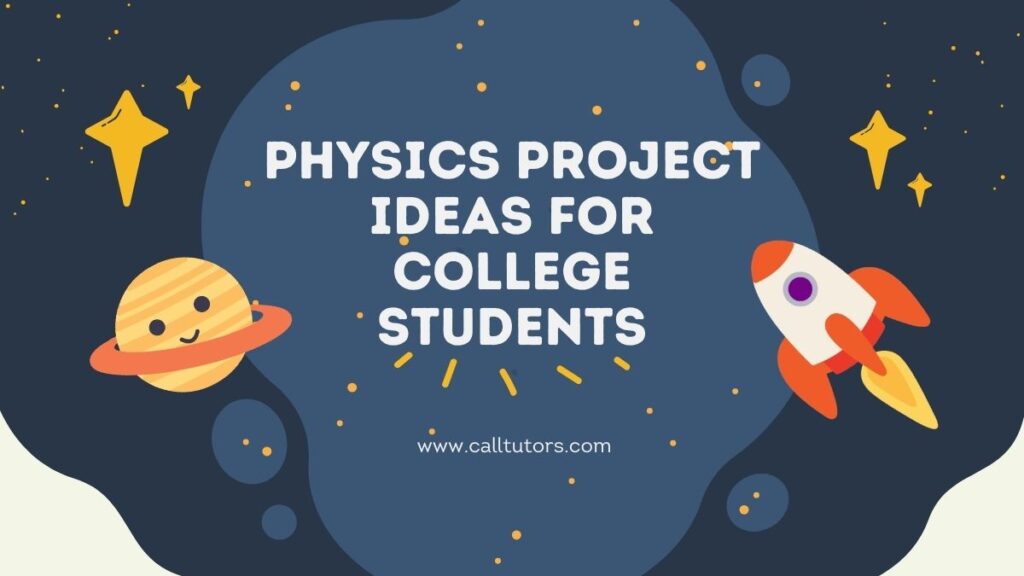Are you a college student who loves science? Get ready for some exciting physics projects! These ideas are not just ordinary school work – they’re like tickets to an amazing journey of exploration and learning.
Whether you’re already crazy about physics or just starting to get interested, there’s something here for you. These projects will make you go, “Wow, physics is cool!”
We’re not going to confuse you with difficult stuff. Our goal is to make physics easy to understand and fun to learn. So, if you’re ready for a hands-on adventure full of scientific discoveries, put on your lab goggles (real or imaginary) and let’s get started!
What are Physics Projects?
Table of Contents
Physics projects are activities or experiments that let you explore different ideas and concepts in physics by doing things yourself.
They can be simple or more complicated and cover topics like how things move, electricity, light, heat, and more.
These projects help you understand what you’ve learned in class by putting it into practice. You might design experiments, collect data, and figure out what it all means.
By doing physics projects, you learn by doing and get a better understanding of how science works.
How To Find Great Physics Topics
Finding good physics project ideas can be tough, but there are ways to make it easier. Here are some practical tips to help you:
- Check out reliable science websites for inspiration.
- Look for physics books in your school library.
- Talk to your teacher or supervisor for guidance.
- Brainstorm with your classmates to come up with ideas together.
If those methods don’t work, you can always ask for help from professional writers. Don’t risk missing out on graduation just because of a project!
Here are some sample physics project ideas to get you started.
Physics Project Ideas for College Students
Have a close look at the physics project ideas for college students:-
Classical Mechanics
- Experiment with different materials to create an efficient trebuchet.
- Build a simple hovercraft and study its motion.
- Investigate the physics of a boomerang’s return flight.
- Analyze the forces involved in a roller coaster loop.
- Study the effects of air resistance on falling objects.
- Build a functional model of a steam engine.
- Investigate the physics of a yo-yo’s motion.
- Explore the principles behind a Newton’s cradle.
- Analyze the mechanics of a trampoline’s bounce.
- Build and test a paper airplane launcher for maximum distance.
Electromagnetism
- Create an electromagnetic levitation system.
- Study the behavior of magnetic fluids (ferrofluids).
- Investigate the physics of electromagnetic radiation using a radio telescope.
- Build a Gauss rifle to demonstrate magnetic acceleration.
- Explore the concept of electromagnetic induction with a homemade generator.
- Analyze the properties of superconducting materials at low temperatures.
- Create a simple electric motor using household materials.
- Study the behavior of electromagnetic waves in different mediums.
- Build a magnetic levitation (maglev) train model.
- Investigate the principles behind wireless power transmission.
Thermodynamics
- Build a solar water heater and measure its efficiency.
- Investigate the physics of heat exchangers.
- Analyze the cooling rates of various beverages in different containers.
- Study the efficiency of a homemade wind turbine generator.
- Investigate the heat transfer properties of different materials.
- Build a DIY thermoelectric generator powered by a temperature gradient.
- Study the principles of a Stirling engine and build a functional model.
- Analyze the thermodynamics of a cryogenic freezing process.
- Investigate the physics of a simple steam turbine.
- Build a solar-powered car and test its efficiency.
Quantum Mechanics
- Conduct a double-slit experiment with particles of your choice.
- Investigate quantum entanglement using a pair of entangled photons.
- Study the behavior of particles in a quantum well.
- Build a basic quantum computer simulator.
- Investigate the properties of quantum dots and their applications.
- Analyze the principles behind quantum teleportation.
- Study quantum cryptography methods and perform secure communication experiments.
- Investigate the physics of Bose-Einstein condensates in a lab setting.
- Explore the concept of quantum superposition with a simple experiment.
- Analyze the behavior of particles in a magnetic field using a cloud chamber.
Relativity
- Build a model to demonstrate time dilation and the twin paradox.
- Study the effects of gravity on the flow of time using a simple experiment.
- Investigate the physics of gravitational lensing using a lens and light source.
- Analyze the principles of relativistic jets in astrophysics with a simulation.
- Build a simple wormhole or black hole analog and study its properties.
- Investigate the physics of warp drives and their feasibility in theoretical physics.
- Study the consequences of a closed, time-like curve and its implications for time travel.
- Analyze the behavior of light in a strong gravitational field (gravitational redshift).
- Build a model illustrating frame-dragging effects in general relativity.
- Investigate the principles behind gravitational wave detection and measurement.
Optics
- Create a holographic display using a laser and holographic plate.
- Investigate the physics of total internal reflection using optical fibers.
- Study the properties of different types of lenses and their applications.
- Build a simple spectrometer to analyze the spectra of different light sources.
- Analyze the dispersion of light in a prism and its effects on a spectrum.
- Study the interference patterns of laser light with a double-slit experiment.
- Investigate the physics of polarized light and its applications in 3D glasses.
- Build a simple optical microscope and explore its magnification capabilities.
- Analyze the properties of diffraction gratings and their use in spectrometry.
- Study the physics of color perception and optical illusions with visual experiments.
Nuclear Physics
- Investigate the properties of different types of radioactive decay.
- Study the behavior of radioactive isotopes and their half-life.
- Build a cloud chamber to detect and visualize cosmic rays.
- Investigate the principles of nuclear fusion reactions and their energy production.
- Analyze the characteristics of a Geiger-Muller counter and its applications.
- Study the behavior of particles in a cyclotron and their acceleration.
- Investigate the physics of nuclear reactors and their operation.
- Analyze the concept of nuclear magnetic resonance (NMR) in medical imaging.
- Study the behavior of neutrinos and their detection methods.
- Investigate the principles of radioactive dating methods in geology and archaeology.
Astrophysics
- Build a simple telescope and observe celestial objects.
- Investigate the physics of different types of stars and their life cycles.
- Study the behavior of galaxies in a cosmic web with a simulation.
- Analyze the effects of dark matter on galaxy dynamics in a computational model.
- Investigate the physics of supernova explosions and their remnants.
- Study the behavior of black holes and event horizons with simulations.
- Analyze the expansion of the universe and its evidence, such as redshift.
- Investigate the properties of exoplanets and their potential habitability.
- Study the cosmic microwave background radiation and its significance.
- Analyze the effects of gravitational waves on the fabric of space-time.
Biophysics
- Investigate the physics of DNA’s double helix structure.
- Study the mechanics of muscle contraction and its role in human movement.
- Analyze the physics of the human circulatory system and blood flow.
- Investigate the behavior of sound waves in human hearing and speech.
- Study the physics of vision and visual perception.
- Analyze the biomechanics of animal locomotion and flight.
- Investigate the physics of neural transmission in the brain.
- Study the principles of medical imaging techniques, such as MRI and CT scans.
- Analyze the physics of bioluminescence in marine organisms.
- Investigate the effects of physical forces on cellular structures and tissues.
Geophysics
- Build a seismometer to detect and analyze earthquake vibrations.
- Investigate the physics of plate tectonics using models and simulations.
- Study the behavior of magnetic fields in Earth’s geodynamo.
- Analyze the principles behind geophysical survey methods, such as ground-penetrating radar.
- Investigate the physics of ocean currents and their impact on climate.
- Study the Earth’s magnetic field and its variations over time.
- Analyze the effects of gravitational forces on Earth’s surface and tides.
- Investigate the properties of geological materials, such as rocks and minerals.
- Study the physics of volcanoes and volcanic eruptions.
- Analyze the Earth’s geothermal energy potential and its utilization for power generation.
These project ideas span the various branches of physics, providing college students with a wide range of topics to explore, experiment with, and investigate in their studies and research endeavors.
How to Choose Physics Ideas for College Students?
Choosing the perfect physics project for college students is like picking the right adventure – it should be exciting, tailored to their abilities, and align with their interests. Here’s a more engaging and natural approach to selecting physics ideas:
Gauge Their Level
To kick things off, take a look at where your students stand academically. Are they just starting their physics journey as freshmen, or are they seasoned seniors? The project’s complexity should match their experience.
Tap into Passion
Find out what lights a fire in your students’ physics-loving hearts. Are they into the mind-bending mysteries of quantum mechanics, the celestial wonders of astrophysics, or perhaps the elegant dance of classical mechanics?
Peek at the Syllabus
Sneak a peek at your college’s physics curriculum. What topics are they currently tackling in the classroom? A project that complements their coursework can make learning more cohesive.
Inventory Resources
Take stock of what you’ve got in your physics toolkit. Do you have a well-equipped lab, specific materials, or faculty support? The project should be doable with the resources at hand.
Unleash Creativity
Encourage your students to dream big! Explore intriguing and cutting-edge topics that spark their curiosity. After all, physics is about uncovering the unknown.
Mix Theory and Hands-On Fun
Balance the scales between theory and experimentation. Projects that involve real hands-on work can turn learning into an adventure.
Career Compatibility
Think about your students’ career ambitions. If they’re aspiring researchers, aim for a project that aligns with their future path.
Team Up for Success
Promote collaboration. Group projects can foster a sense of camaraderie and help students learn from each other.
Ask the Experts
Reach out to your fellow physics pros. Consult with faculty members who can lend their wisdom in selecting the perfect project.
Match Timeframes
Ensure the project fits within the allotted time. Some are quick and snappy, while others are more of a marathon. Choose wisely.
Real-World Relevance
Look for projects with real-world applications. Connecting physics to practical life can be incredibly motivating.
Flexibility Matters
Pick a project that allows for twists and turns. Unexpected discoveries and challenges are all part of the thrilling physics adventure.
Historical Hits
Dive into the archives of past student projects. Success stories from the past can inspire the next generation.
Student Input is Key
Lastly, let your students have their say. After all, they’re the ones embarking on this physics journey. Their enthusiasm and ideas can make the adventure even more exciting.
With this approach, you’ll embark on a physics journey that’s not just educational but also an absolute blast!
Wrap Up!
And that brings us to the end of our tour through these awesome physics projects for college students. But hold on, this isn’t a farewell; it’s just the start of your scientific adventure!
Think of these projects as your keys to unlocking the mysteries of the universe, but without the complicated jargon. They’re like your backstage pass to the world of physics, where you get to see the magic happen up close and personal.
These projects aren’t just about acing assignments; they’re about having fun, being curious, and understanding the world in a whole new way. You’re not just learning facts; you’re becoming a scientist – someone who asks questions, runs experiments, and discovers cool stuff.
So, whether you’re launching things into the air, creating rainbows of light, or using the sun’s power, remember that science is an adventure, and you’re the fearless explorer. The universe has endless secrets waiting for you to uncover.
In the end, physics is like a treasure hunt, and these projects are your map. They lead you to discoveries, aha moments, and a deeper appreciation for the world around you. So, grab your lab coat, put on your explorer’s hat, and let’s keep this physics party going!
Frequently Asked Questions
How can I choose the right physics project for me?
Consider your interests and the subfield of physics that intrigues you the most. Choose a project that aligns with your passion.
Are these projects suitable for beginners in physics?
Yes, some of the projects are designed with beginners in mind, while others may require more advanced knowledge. Choose one that matches your skill level.
Do I need expensive equipment for these projects?
The complexity of the project determines the equipment required. Many projects can be done with basic materials, while others may need specialized tools.
Can these projects be done as group assignments?
Absolutely! Collaborating with fellow students can enhance the learning experience and make complex projects more manageable.
How can I ensure the safety of my experiments?
Always prioritize safety by following proper procedures, wearing protective gear, and seeking guidance from professors or mentors when needed.



